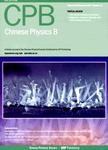Introduction of F_4-TCNQ/MoO_3 layers for thermoelectric devices based on pentacene
Introduction of F_4-TCNQ/MoO_3 layers for thermoelectric devices based on pentacene作者机构:Life BEANS Center KyushuBio Electromechanical Autonomous Nano-Systems(BEANS) Laboratory744 MotookaNishi-kuFukuoka 819-0395Japan Center for Future ChemistryKyushu University744 MotookaNishi-kuFukuoka 819-0395Japan School of Optoelectronic InformationUniversity of Electronic Science and Technology of China (UESTC) Center for Organic Photonics and Electronics Research (OPERA) and International Institute for Carbon Neutral Energy Research (WPI-I2CNER)Kyushu University744 MotookaNishiFukuoka 819-0395Japan
出 版 物:《Chinese Physics B》 (中国物理B(英文版))
年 卷 期:2014年第23卷第9期
页 面:535-538页
核心收录:
学科分类:081704[工学-应用化学] 08[工学] 0817[工学-化学工程与技术]
基 金:supported by the New Energy and Industrial Technology Development Organization(NEDO) the Funding Program for World-Leading Innovative R&D on Science and Technology(FIRST) the International Institute for Carbon Neutral Energy Research(WPI-I2CNER)sponsored by MEXT
主 题:thermoelectrics pentacene MoO3 contact resistance
摘 要:We introduced a dual electron accepting layer composed of tetrafluoro-tetracyanoquinodimethane (F4-TCNQ) and MoO3 for thermoelectric devices based on a pentacene layer. We found that the power factor is enhanced by placing an F4-TCNQ layer directly in contact with the pentacene layer and it is also enhanced by placing a MoO3 layer between the F4-TCNQ layer and the Au electrode. By examining the contact resistance using a field effect transistor and a hole-only diode, we confirmed that the hole injection is improved due to the reduction of contact resistance at the interface between the MoO3 layer and the Au electrode.



